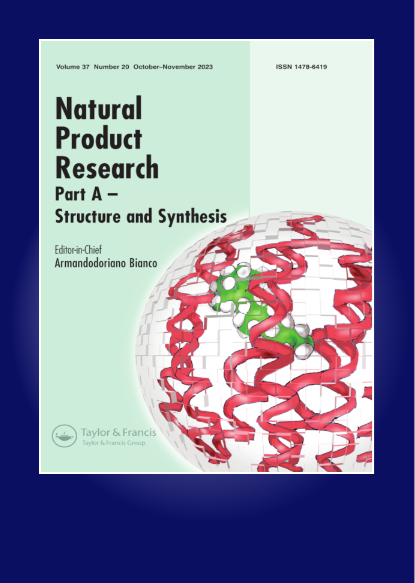用ESI(-) FT-ICR质谱分析单叶Eugenia叶片中酚类化合物的性质、对胃腺癌(AGS)细胞的细胞毒活性和抗幽门螺杆菌活性。
IF 1.9
3区 化学
Q3 CHEMISTRY, APPLIED
引用次数: 0
摘要
Eugenia uniflora的叶子是类黄酮和鞣花单宁的来源,巴西人用它们来治疗各种疾病,包括胃肠道疾病。本研究旨在确定乙醇提取物和其他衍生物是否为有效的抗胃腺癌(AGS)细胞和抗h。幽门螺杆菌病原体,其化学成分,质谱表征较丰富的化合物。结果与文献进行比较。水溶液中含有丰富的鱼醋苷B和Gemin D/Hippomanin A,具有抗h活性。与其他样本相比,AGS细胞的幽门螺杆菌活性和更高的细胞毒性此外,ESI(-) FT-ICR MS表征了更丰富的酚类化合物,包括奎宁酸,杨梅苷,Gemin D/Hippomanin A和Oenothein。因此,乙醇提取物和水馏分对胃癌和抗幽门螺杆菌的活性似乎源于单宁和黄酮类化合物的抗增殖和抑菌作用。本文章由计算机程序翻译,如有差异,请以英文原文为准。
Characterization of phenolic compounds in Eugenia uniflora leaves by ESI(-) FT-ICR MS, analysis of cytotoxic activity on gastric adenocarcinoma (AGS cells), and anti-Helicobacter pylori activity
Eugenia uniflora leaves are a source of flavonoids and ellagitannins, and the Brazilian population uses them to treat various diseases, including gastrointestinal disorders. This study aimed to determine if the ethanol extract and other derivatives are effective cytotoxic agents against gastric adenocarcinoma (AGS cells) and anti-H. pylori agent, its chemical composition, and mass spectrometry characterization of the more abundant compounds. The results were compared with the literature. The aqueous fraction, rich in Oenothein B and Gemin D/Hippomanin A, showed anti-H. pylori activity and higher cytotoxicity on AGS cells compared to the other samples analysed. Furthermore, the ESI(-) FT-ICR MS characterized the more abundant phenolic compounds, including Quinic Acid, Myricitrin, Gemin D/Hippomanin A, and Oenothein. Therefore, the activity of the ethanolic extract and aqueous fraction for gastric cancer and against H-pylori seems to originate from the antiproliferative and bacteriostatic effects of tannins and flavonoids.
求助全文
通过发布文献求助,成功后即可免费获取论文全文。
去求助
来源期刊

Natural Product Research
化学-医药化学
CiteScore
5.10
自引率
9.10%
发文量
605
审稿时长
2.1 months
期刊介绍:
The aim of Natural Product Research is to publish important contributions in the field of natural product chemistry. The journal covers all aspects of research in the chemistry and biochemistry of naturally occurring compounds.
The communications include coverage of work on natural substances of land and sea and of plants, microbes and animals. Discussions of structure elucidation, synthesis and experimental biosynthesis of natural products as well as developments of methods in these areas are welcomed in the journal. Finally, research papers in fields on the chemistry-biology boundary, eg. fermentation chemistry, plant tissue culture investigations etc., are accepted into the journal.
Natural Product Research issues will be subtitled either ""Part A - Synthesis and Structure"" or ""Part B - Bioactive Natural Products"". for details on this , see the forthcoming articles section.
All manuscript submissions are subject to initial appraisal by the Editor, and, if found suitable for further consideration, to peer review by independent, anonymous expert referees. All peer review is single blind and submission is online via ScholarOne Manuscripts.
 求助内容:
求助内容: 应助结果提醒方式:
应助结果提醒方式:


